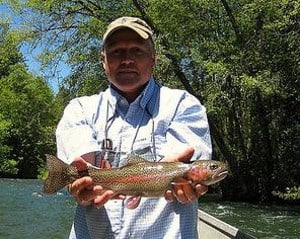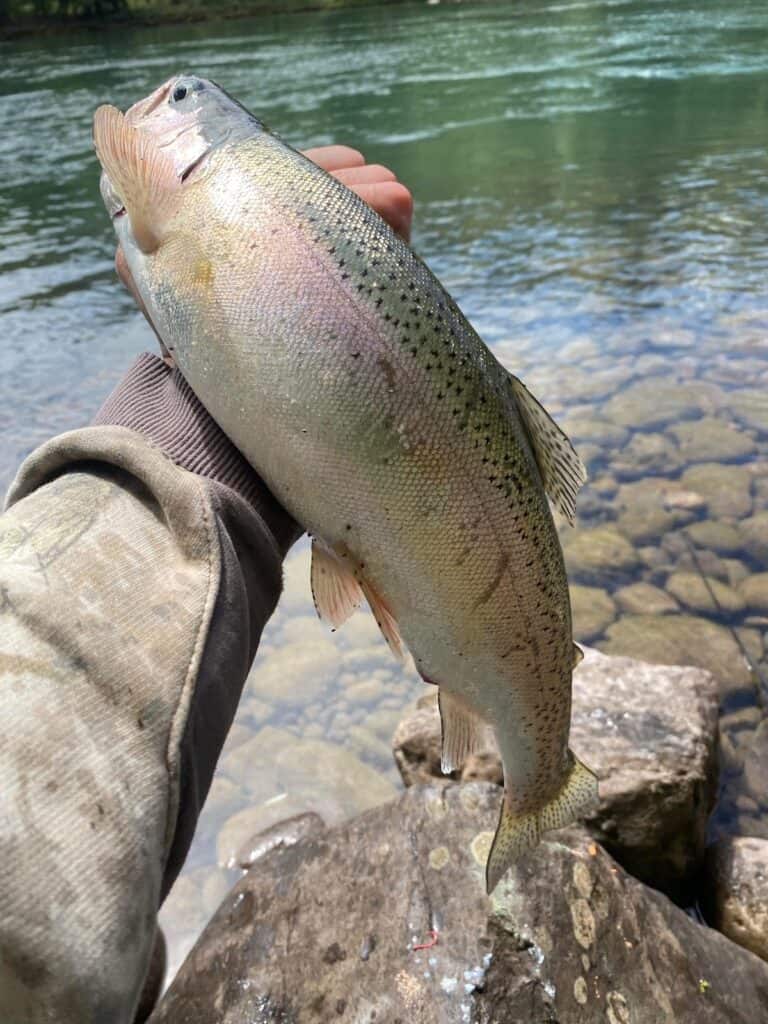This is one of two major forks that come together at the start of the mainstem Willamette River. It flows out of the high Cascade Mountains and joins with the Coast Fork at the edge of Eugene and Springfield.
The lower river is most often fished for its salmon and steelhead runs each spring and summer, while above the dams trout rule the fishery.
This river is now open for year-round fishing, even for trout.
This article will tackle the river’s three distinct sections:
Lower River
Salmon and Steelhead
Spring Chinook salmon and summer steelhead, released as hatchery-reared smolts, return to the lower Middle Fork Willamette each year.
The first of both runs can show up in early spring, but better numbers will build by late spring and early summer.
Runs of anadromous fish vary wildly. Some years back this section would fill with thousands and thousands of springers and summer steelies. More recently the returns have been modest.
Most salmon and steelhead fishing here is in the few miles below Dexter Dam, where these big fish congregate within a short drive of the cities.
There is access below the dam off Highway 58 and a little downriver at Elijah Bristow State Park. Farther downstream, the Middle Fork is less defined by pools and runs and harder to fish. It’s also harder to get to.
For more on this and related fisheries, see Willamette Valley’s Best Spring Chinook Fishing and Willamette Valley’s Best Summer Steelhead Fishing.
Trout
There are wild trout in the lower reaches (it’s not stocked), but it’s not nearly the trout fishery that exists farther up this river and definitely not the draw of the nearby McKenzie River.
You may keep two trout per day (8-inch minimum) in this lower section. If you’re looking for stocked trout nearby, try Fall Creek and Fall Creek Reservoir and Dexter Reservoir.
Bait fishing is allowed in the lower river, but check regulations for several special rules specific to this water designed to deter illegal snagging, especially below the dam.
Walleye
Walleye have been caught in the big pool right below Dexter Dam for quite a few years now.
Some are caught deliberately, while steelhead and salmon anglers also find one of these Midwest delicacies on their hook now and then.
Nightcrawlers, jigs, and crankbaits are commonly used to catch walleye.
We won’t be surprised to hear about some walleye being caught downriver on the Middle Fork Willamette (and into the mainstem) as well.
Bass
Increasingly, bass are showing up in the catches in the river below Dexter Dam, including both smallmouth and largemouth bass. Both species of bass also are common in both Dexter Reservoir and Lookout Point Lake upriver.
Typical bass lures such as soft plastic grubs on jig heads, crankbaits, spinners and other lures will catch bass, as will a simple nightcrawler drifted through pools and pockets.
Middle River
This is the Oakridge stretch, from below Hills Creek Reservoir to the upper end of Lookout Point Reservoir.
This area has long been maintained as a catch-and-release fishery for wild trout, and it can be very productive for fly anglers. It’s less popular than the McKenzie in this regard, but it also faces less pressure.
Bank access is available at several points along Highway 58 and local roads, plus at Greenwaters Park on the east side of Oakridge. Skilled boaters can navigate the lower end when water conditions allow.
This stretch is open year-round but anglers must only use artificial flies and lures, not bait. Only fin-clipped trout may be kept. These are not stocked, but the occasional hatchery-marked fish may slip downstream.
Walleye have become well-established in Lookout Point Lake and may occasionally run into the river just above the reservoir, but they likely won’t fight through many rapids so their range would be limited.
Upper River
This section of the stream above Hills Creek Reservoir previously was stocked with hatchery-reared trout.
Stocking has now ended and the upper reaches are managed for wild trout.
The trout originally destined for the upper river have been planted in the reservoir itself.
ODFW saves money by avoiding frequent truck trips to deliver fish that weren’t considered highly utilized in the stream, plus the upper river also is home to protected bull trout.
This section of stream is likely to get better for strictly catch-and-release angling with artificial flies and lures only for all wild trout species, including native cutthroat, rainbow, and bull trout.
There also are non-native brook trout in the cold upper reaches. While in many Oregon waters anglers can keep brook trout (and in some places they can keep all they catch), the rules governing the Middle Fork Willamette above the reservoirs are decidedly different and require the release of all unclipped trout including brookies.
Bull and brook trout are both on the char branch of the trout family tree and can be confused with one another.
To get here, follow signs to Hills Creek Reservoir just east of Oakridge. Keep to the right to follow National Forest Service Road 21 up the west side of the reservoir and up the Middle Fork.
With changes in several recent years, it would be a great idea to check angling regulations before going fishing.
For nearby keeper trout, find hatchery planters in Hills Creek Reservoir and Salmon Creek, and some wild harvest in Hills Creek and Salt Creek.
Find More Fishing Spots in Lane County
Oregon Resources
ODFW Weekly Fishing Report
ODFW Trout Stocking Schedule
Oregon Fishing Regulations
National Weather Service


